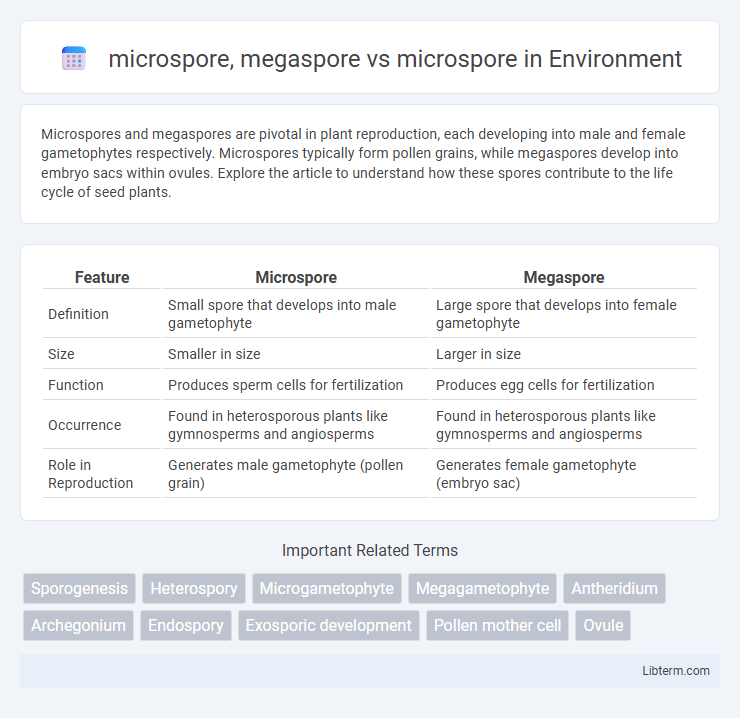Microspores and megaspores are pivotal in plant reproduction, each developing into male and female gametophytes respectively. Microspores typically form pollen grains, while megaspores develop into embryo sacs within ovules. Explore the article to understand how these spores contribute to the life cycle of seed plants.
Table of Comparison
| Feature | Microspore | Megaspore |
|---|---|---|
| Definition | Small spore that develops into male gametophyte | Large spore that develops into female gametophyte |
| Size | Smaller in size | Larger in size |
| Function | Produces sperm cells for fertilization | Produces egg cells for fertilization |
| Occurrence | Found in heterosporous plants like gymnosperms and angiosperms | Found in heterosporous plants like gymnosperms and angiosperms |
| Role in Reproduction | Generates male gametophyte (pollen grain) | Generates female gametophyte (embryo sac) |
Introduction to Spores in Plant Reproduction
Microspores and megaspores are critical to plant reproduction, originating from meiosis in spore mother cells within the microsporangia and megasporangia respectively. Microspores develop into male gametophytes or pollen grains, whereas megaspores give rise to female gametophytes inside ovules. Understanding the distinct roles of microspores and megaspores is essential for studying the alternation of generations in seed plants and the evolution of reproductive strategies.
What is a Microspore?
A microspore is a haploid spore that develops into a male gametophyte in seed plants, playing a crucial role in plant reproduction by producing pollen grains. Unlike a megaspore, which develops into a female gametophyte, microspores are smaller and numerous, ensuring the propagation of male genetic material. Microspores originate from microsporocytes through meiosis, highlighting their importance in the alternation of generations in vascular plants.
What is a Megaspore?
A megaspore is a type of spore in plants that develops into a female gametophyte and is typically larger than a microspore. While microspores give rise to male gametophytes, megaspores undergo mitotic divisions to form the embryo sac within the ovule, crucial for fertilization in seed plants. Differences between microspores and megaspores lie in their size, function, and the type of gametophyte they produce, with megaspores playing a central role in seed development and reproduction.
Origin and Development of Microspores
Microspores originate from microsporocytes through meiosis within the microsporangia of seed plants, leading to the formation of haploid microspores that develop into male gametophytes. In contrast, megaspores arise from megasporocytes in the ovule's megasporangium and develop into female gametophytes. The development of microspores involves mitotic divisions forming pollen grains that carry sperm cells, essential for fertilization and seed formation.
Origin and Development of Megaspores
Megaspores originate from the megasporocyte within the ovule of seed plants through meiotic division, developing into the female gametophyte or embryo sac. In contrast, microspores arise from microsporocytes in the anthers and give rise to male gametophytes or pollen grains. The development of megaspores involves one functional megaspore after meiosis, while microsporocytes produce multiple viable microspores.
Structural Differences: Microspore vs Megaspore
Microspores are typically smaller, haploid spores that develop into male gametophytes, featuring a relatively simple structure with a thin wall. Megaspores, significantly larger in size, serve as female gametophyte precursors and possess a thicker wall to provide protection during embryo sac development. Structural differences between microspores and megaspores reflect their distinct roles in sexual reproduction, with microspores adapted for dispersal and fertilization, while megaspores ensure nutrient support and protection for future seeds.
Functional Roles in Plant Life Cycles
Microspores develop into male gametophytes responsible for producing sperm cells, while megaspores develop into female gametophytes that generate egg cells essential for fertilization. Microspores contribute to pollen grain formation, facilitating pollen dispersal and fertilization, whereas megaspores support embryo sac development within ovules, crucial for seed formation and plant reproduction. These complementary roles ensure successful sexual reproduction and genetic diversity in angiosperms and gymnosperms.
Microsporogenesis vs Megasporogenesis
Microsporogenesis is the process through which microspores develop into male gametophytes, involving meiosis in microspore mother cells within the anthers of flowering plants. Megasporogenesis produces megaspores via meiosis in the ovules, forming female gametophytes critical for seed development. The key distinction lies in microsporogenesis generating four viable microspores, while megasporogenesis typically yields one functional megaspore and three degenerative cells.
Evolutionary Significance of Spore Differentiation
Microspore and megaspore differentiation represents a crucial evolutionary advancement in plant reproductive strategies, enabling heterospory that enhances genetic diversity and adaptation. Microspores develop into male gametophytes while megaspores form female gametophytes, optimizing resource allocation and reproductive efficiency. This specialization underpins the evolution of seed plants by facilitating complex reproductive cycles and improving survival rates in varying environments.
Key Comparisons: Microspore and Megaspore at a Glance
Microspores and megaspores differ primarily in size, function, and development: microspores are smaller and develop into male gametophytes, while megaspores are larger and give rise to female gametophytes. In seed plants, microspores are produced by microsporocytes through meiosis and form pollen grains, whereas megaspores are produced by megasporocytes and develop within the ovule. This fundamental distinction supports sexual reproduction by ensuring specialized roles in gamete formation and fertilization.
microspore, megaspore Infographic

 libterm.com
libterm.com